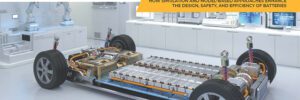Automaker Stellantis and nuclear energy company Orano have signed a memorandum of understanding to form a joint venture to recycle EV batteries and scrap. The new venture will provide Stellantis with access to cobalt, nickel, and lithium from gigafactories in Europe and North America for electrification and energy transformation. The joint venture will produce “black mass” or “active mass” which will be refined in a new hydrometallurgical plant Orano will build in Dunkirk, France. This plant is expected to have metal recovery rates of over 90%.
The joint venture will also provide Stellantis’s partners, its after-sales network, and other OEMs with a solution to manage end-of-life batteries and scrap from gigafactories. Production is expected to commence in early 2026 using Stellantis assets and facilities.
Alison Jones, Senior VP of Stellantis’s Circular Economy Business Unit, commented on the agreement saying, “The United Nations’ Sustainable Development Goals has confirmed the need to find solutions like this one with Orano to meet the challenge of natural resource scarcity and sustainability.”
The joint venture between Stellantis and Orano is an important step towards creating a more sustainable future. By recycling EV batteries and scrap, the two companies are helping to reduce the amount of waste that ends up in landfills. This is an important step towards achieving the UN’s Sustainable Development Goals.
FAQ
Q1: Are electric car batteries recyclable?
A1: Yes, electric car batteries are recyclable.
Q2: Are electric car chargers free?
A2: It depends on the charger and the location. Some electric car chargers are free, while others may require a fee.
Q3: Can electric car batteries be rebuilt?
A3: Yes, electric car batteries can be rebuilt with the right tools and knowledge.








